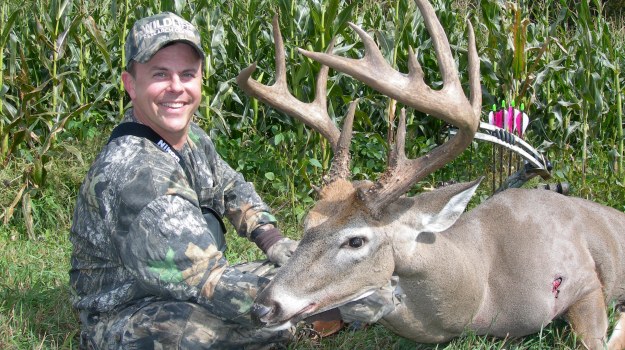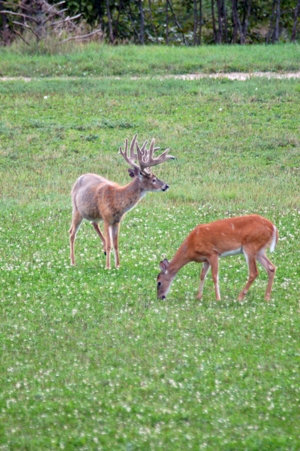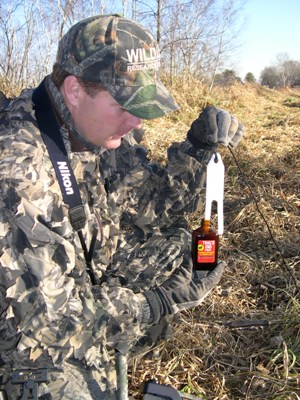
Early Season Whitetail Strategies
By Todd Amenrud
Understanding the social structure of the herd during the time you intend to hunt is a key to getting various hunting tactics to work for you. In the “whitetails’ world” the time during early season is all about being social with other deer; however, they may not be communal with the specific deer that you might think. Some hunters feel that they shouldn’t use certain calls or scent until just before the rut. Actually, early season can be the easiest time to draw a response. You just need to know which smells, sounds or decoy postures they favor during that time and how to set them up so the encounter ends in your favor.
During late summer and early fall whitetails can be very social; however, they are primarily social only within their own sex groups. You may see them feeding side by side in an agricultural field, but for the most part the bucks are sociable with other bucks, possibly in their bachelor groups, and the doe / fawn family groups are social with other does and fawns. Testosterone will change things soon, but for a short while during early season this is the case.
 Knowing this to be true, it makes the best sense to use “buck smells, buck sounds or bucks decoys” to attract bucks and “doe smells, doe/fawn sounds or doe and fawn decoys” to attract does or fawns. For scent utilization, this obviously is applicable only to “deer smells” (scents that actually come from deer, like urine, glandular lures or musk type smells); this is not the case for curiosity smells or food lures.
Knowing this to be true, it makes the best sense to use “buck smells, buck sounds or bucks decoys” to attract bucks and “doe smells, doe/fawn sounds or doe and fawn decoys” to attract does or fawns. For scent utilization, this obviously is applicable only to “deer smells” (scents that actually come from deer, like urine, glandular lures or musk type smells); this is not the case for curiosity smells or food lures.
When it comes to more mature bucks, they may, or may not be social with other bucks. Sometimes older bucks can become very isolated animals. They really don’t need this communal contact like younger bucks seem to want.
During September dramatically increased amounts of testosterone start flowing through the buck’s body. Contrary to what some believe, from this point on he is ready to breed. The further south you go the later this seems to happen and it will be spread out over a longer period, so in the south there is a bit more of a margin for error. Differing to what some may say it’s the does that actually dictate when breeding will take place. Bucks will typically remain social with the other bucks until the does exhibit the first signs of coming into estrus.
Although, I’ve had a positive reaction to breeding tactics during early season, it’s probably not a good idea to go out opening day and “smack them in the nose” with breeding or competition scenarios.
Typically when it comes to “deer smells” you want to use the smells/scents when they would naturally occur anyhow. As I said, I’ve had estrus lures work well on mature bucks early in the season. And, if you are specifically after a mature buck, it may be a tactic you wish to try, but for most early season instances you are probably better off with plain urine or a curiosity scent like Trail’s End #307.
There are many ways that you can dispense scent during this period, but two of my favorite tools are; a Pro-Drag and Magnum Scrape Dripper. The Pro-Drag is the best tool that I have found to create a scent trail with because it holds a lot of scent and it’s easy to control. You can use any type of liquid scent when making a trail, it doesn’t have to be a “deer smell,” you are alright to use food lures or curiosity scents too.
When testosterone enters the picture mock scrapes can be a very effective tactic, even as early as the last part of September. Where sometimes using mock scrapes too early in the year can be intimidating to young bucks, it may be “just the ticket” for those “breeding class” bucks. Mature bucks will feel the urge to claim, mark and defend breeding territory earlier in the season than the younger bucks.
 The Magnum Scrape Drippers that are associated with making mock scrapes are great tools for dispensing any type of liquid scent, not just those associated with mock scrapes. This device is heat activated and will drip only during daytime hours, conditioning deer to showing up during legal hunting hours. It doesn’t have to be used just at mock scrapes; it works great at dispensing all kinds of scent like food lures or curiosity scent too.
The Magnum Scrape Drippers that are associated with making mock scrapes are great tools for dispensing any type of liquid scent, not just those associated with mock scrapes. This device is heat activated and will drip only during daytime hours, conditioning deer to showing up during legal hunting hours. It doesn’t have to be used just at mock scrapes; it works great at dispensing all kinds of scent like food lures or curiosity scent too.
You can operate for two to three weeks on one fill-up with the Magnum Scrape Dripper. Actually you don’t want to fill it up. It works because of the air pocket that you leave inside, but you can use a full 4 ounces of scent. This unit freshens your scent set-up during legal shooting hours so you don’t have to. This way when you’re ready to hunt, the site is pristine and void of human scent.
Around opener, and for the following couple weeks, a scent trail of Trail’s End #307 can be “killer.” One reason why this lure is so effective is because it appeals not only to a whitetail’s curiosity but also to their sense hunger and desire to repopulate - you really can’t go wrong.
Calling whitetails can sometimes be easy during early season. Whitetails are social animals and the bucks want to socialize with other bucks to see where they will eventually end up in the breeding hierarchy, and doe/fawn family groups want to get to know the other doe/fawn family groups after the solitude they experienced during birth and shortly after. Soft, social calls typically will work best.
Rattling will work during early season. As soon as bucks lose their velvet they start sparing with one another. When rattling, “this light social situation” is what you want to reproduce. You don’t want to imitate two bucks in a knock-down, drag-out fight rather “you’re two brothers in a friendly arm wrestling match.” Just “tickle” your antlers together. And rather than aggressive vocalizations, you would use soft, social buck calls.
If you do catch them in their dependable summer patterns, move fast! With testosterone entering the picture and the does soon to show signs of coming into estrus things will change very fast.




























